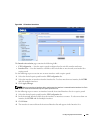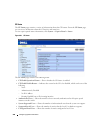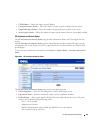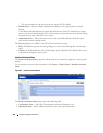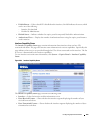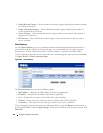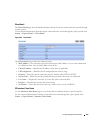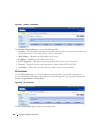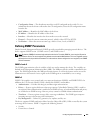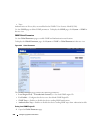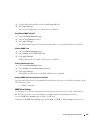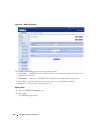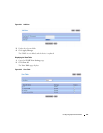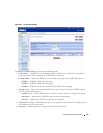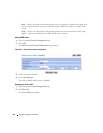
Configuring System Information 207
•
Configuration Name
— The drop-down menu lists each CP configured on the switch. To view
information about the clients connected to the CP configuration, select the CP configuration name
from the list.
•
MAC Address
— Identifies the MAC address of the client.
•
IP Address
— Identifies the IP address of the client.
•
Interface
— Identifies the interface the client used to access the network.
•
Protocol
— Shows the current connection protocol, which is either HTTP or HTTPS.
•
Verification
— Shows the current account type, which is Guest, Local, or RADIUS.
Defining SNMP Parameters
Simple Network Management Protocol (SNMP) provides a method for managing network devices. The
device supports SNMP version 1, SNMP version 2, and SNMP version 3.
Note: By default, SNMPv2 is automatically enabled on the device. To enable SNMPv3, a local engine ID must be
defined for the device. The local engineID is by default set to the switch MAC address. This local engineID must be
defined so that it is unique within the network. For information on how to configure the local engine ID, see "SNMP
Global Parameters."
SNMP v1 and v2
The SNMP agent maintains a list of variables, which are used to manage the device. The variables are
defined in the Management Information Base (MIB). The MIB presents the variables controlled by the
agent. The SNMP agent defines the MIB specification format, as well as the format used to access the
information over the network. Access rights to the SNMP agent are controlled by access strings.
SNMP v3
SNMP v3 also applies access control and a new traps mechanism to SNMPv1 and SNMPv2 PDUs. In
addition, the
User Security Model (USM) is defined for SNMPv3 and includes:
•
Authentication
— Provides data integrity and data origin authentication.
•
Privacy
— Protects against disclosure of message content. Cipher-Bock-Chaining
(CBC) is used for
encryption. Either authentication is enabled on an SNMP message, or both authentication and privacy
are enabled on an SNMP message. However privacy cannot be enabled without authentication.
•
Timeliness
— Protects against message delay or message redundancy. The SNMP agent compares
incoming message to the message time information.
•
Key Management
— Defines key generation, key updates, and key use.
The device supports SNMP notification filters based on Object IDs (OID). OIDs are used by the system
to manage device features. SNMP v3 supports the following features:
•Security
•Feature Access Control



